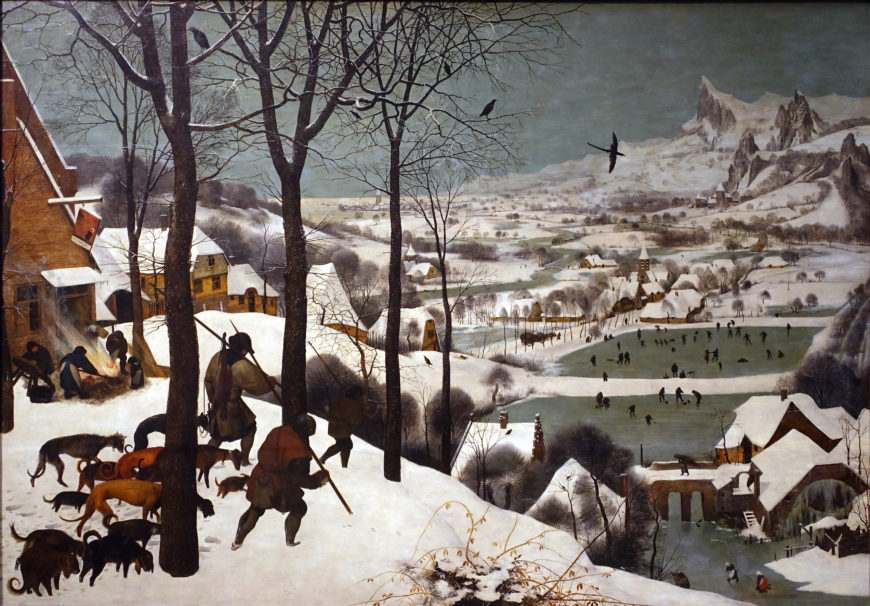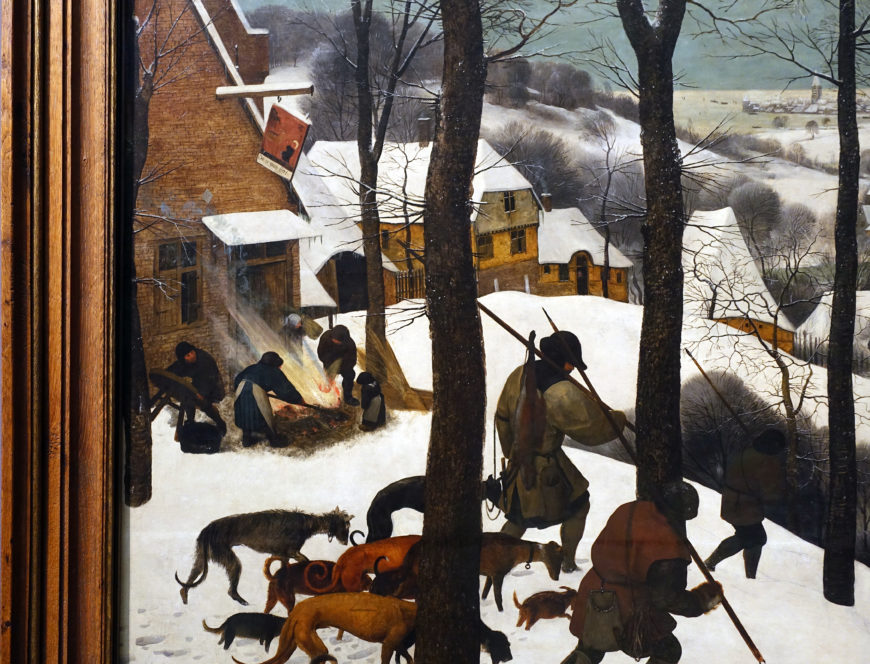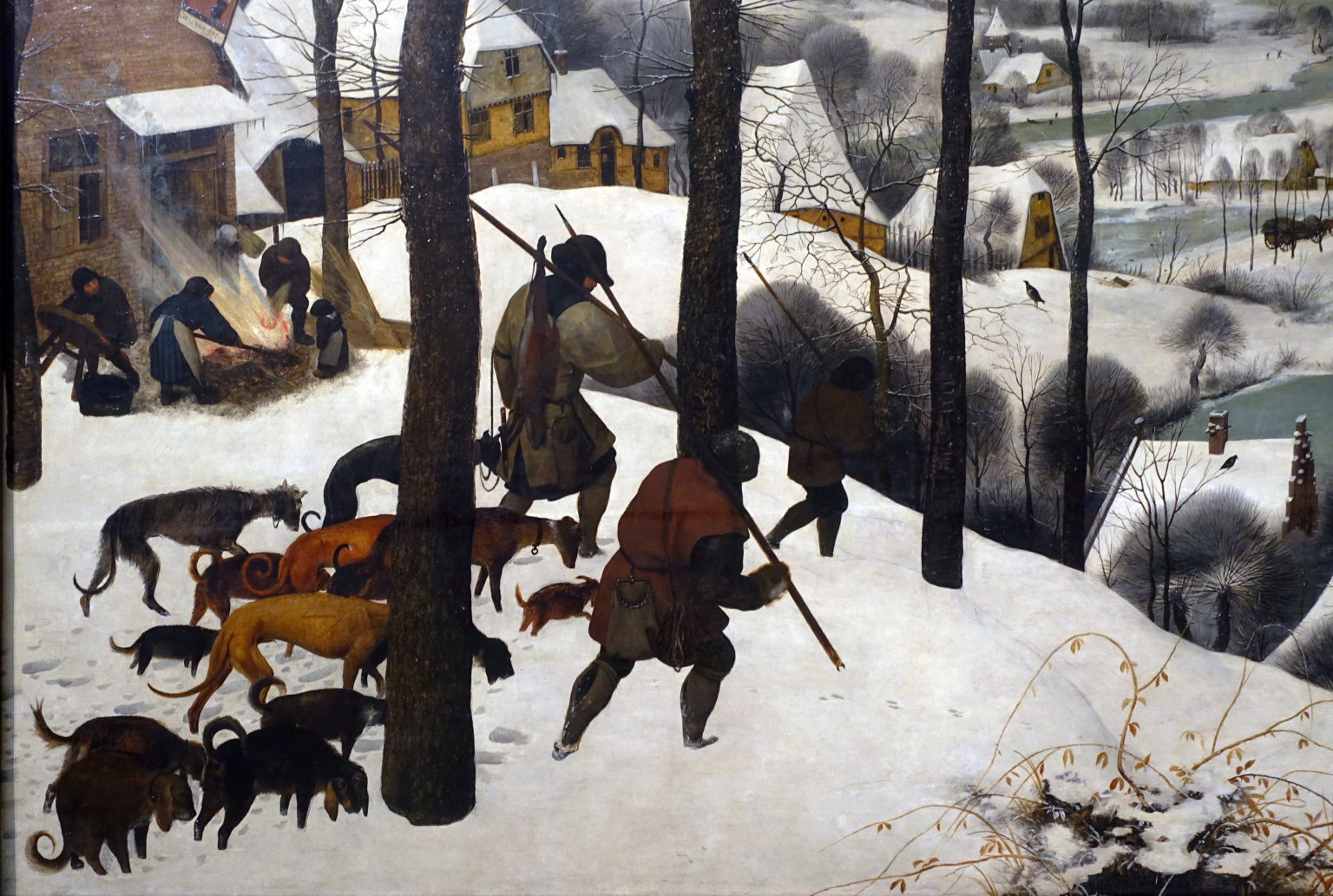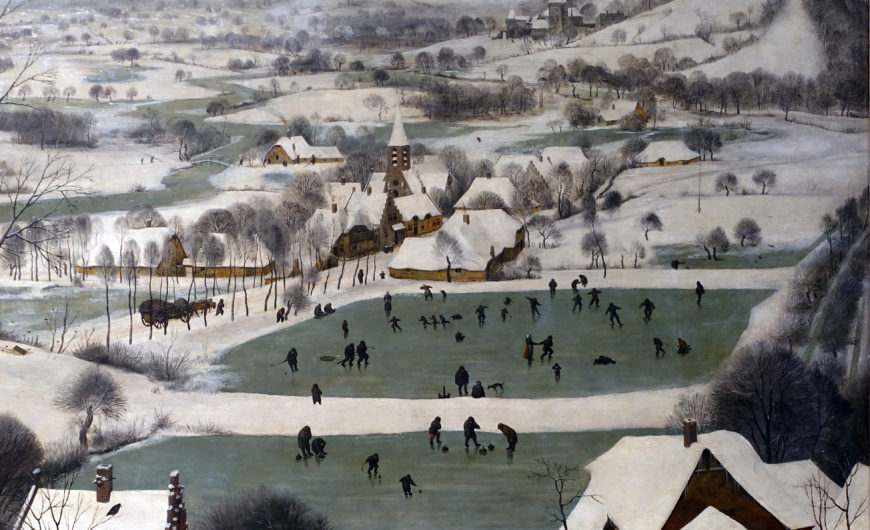Pieter Bruegel the Elder, Hunters in the Snow (Winter)

The painting, usually interpreted as a genre scene (an image of daily life), features a snow-covered landscape that recedes dramatically to a row of jagged mountains in the distance, all under a blue-grey sky. In the lower left corner a trio of hunters and their pack of dogs return from a hunt. Beside them is an inn, and its rust-colored bricks and the bright yellow fire in front of it are a striking contrast to the whites and grays and ashy blues that dominate the painting.

From the left side of the painting the land slopes down and to the right, and beyond the foreground the landscape drops away sharply. The extensive middle ground and background, rendered in minute detail, depicts the natural and manmade world: a person carrying a load of sticks over a bridge, figures ice skating on a frozen pond, the snow-covered roofs of houses, innumerable tiny bare trees, and—far in the distance on the right side—the grey and snowy mountains, whose rough peaks seem to scratch at the sky. The right side of the painting is thus an uninterrupted view across the snowy valley. We see everything so clearly—even way into the distance it’s possible to make out individual trees and rooftops—and so we sense the crisp and clear air of a winter day.
Yet this is not at all an image from reality: there is no such landscape in the Netherlands (which is mostly flat and below sea level in some areas). Rather, Bruegel combined images from his surroundings—the inns and farmhouses and frozen ponds of Northern Europe—with a chain of jagged mountains reminiscent of the Alps, which he saw on a journey to Italy in the 1550s. The painting is thus a carefully constructed scene, drawn as much from the artist’s imagination as from his surroundings.

Close looking: searching for the details
The hunters and their dogs are the largest figures in the painting and their group takes up much of the lower left quarter of the image. But rather than a scene of triumph, Bruegel is showing us a rather unsuccessful hunt. The men trudge through the snow wearily; note, for example, how the figure closest to us leans forward slightly, as though using his own body to keep his momentum—and his spirits—going. Each man also has his head cast downward, in a pose reminiscent of defeat. Even the dogs appear downtrodden, as several in the extreme lower left hang their heads—a point exaggerated by their drooping ears.

The group’s low spirits can be explained by the fact that only one of them carries back a trophy: a rather small fox. Furthermore, a trail of rabbit tracks in front of the foremost hunter suggests that more prey have recently escaped them.
The figures in front of the inn are preparing a fire for the singeing of a pig—a traditional December activity—and in the distance people take pleasure in the frozen lake: ice skating, playing hockey or a form of curling, and pulling companions on sleds.

The painting’s commission and sources
Bruegel’s painting, with its bare trees and people bundled against the cold and hard-packed snow, is part of a long tradition in Northern European art of portraying the months of the year and the activities that occurred during each month. Among the most famous examples is the cycle found in the Limbourg Brothers’ Très Riches Heures du Duc de Berry.
In Bruegel’s case the paintings were commissioned by a wealthy Antwerp banker named Niclaes Jongelinck. Rather than twelve paintings, Bruegel’s cycle divided the year into six seasons (paintings for five survive). He has also chosen to give as much or more emphasis to the landscapes than to the depicted activities, with particular attention paid to the shifting colors of the times of year, from dark brown to blues and greens to yellows. This image—of winter—is the last in the series, dominated by whites and pale blues. If we imagine how they might have been displayed together in a room in Jongelinck’s house the effect would have been a chromatic progression through the seasons.[1]
- Dr. David Boffa, "Pieter Bruegel the Elder, Hunters in the Snow (Winter)," in Smarthistory, December 11, 2015, accessed March 31, 2023, https://smarthistory.org/pieter-bruegel-the-elder-hunters-in-the-snow-winter/ ↵

